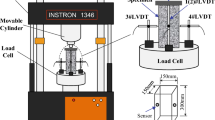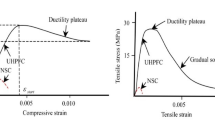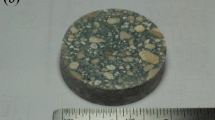The stress-strain model of concrete depends on the degree of frictional resistance across the loading surfaces of a test specimen depending on the antifriction medium used during testing. This article presents a comparative study of platen restraint on the behavior of concrete under uniaxial compression based on an experimental investigation. The effect of four commercially available antifriction media (neoprene, polyvinyl chloride, teflon, and grease) with different layer thicknesses on platen restraint have been studied for a normal strength concrete and a relatively high-strength concrete. Subsequently, the effect of platen restraint has been quantified using the analogy of toughness. The experimental results indicate that post-ultimate response of concrete is significantly affected by platen restraint. It is shown that the stress–strain curve obtained from a conventional uniaxial compression test not only describes specimen/material behavior but also represents interaction between specimen and loading platen. Among the four antifriction media used in this investigation, grease is the most effective in reducing frictional resistance. Failure patterns of the concrete specimens for different antifriction media are also subsequently analyzed.





Similar content being viewed by others
References
Plain and Reinforced Concrete – Code of Practice IS 456:2000, Bureau of Indian Standards (2000).
R. Park and T. Paulay, Reinforced Concrete Structures, Wiley Interscience Publication (1974).
B. Bresler and K. S. Pister, “Strength of concrete under combined stresses,” ACI J. Proc., 55, No. 9, 321–345 (1958).
K. T. S. R. Iyengar, K. Chandrashekhara, and K. T. Krishnaswamy, “Strength of concrete under biaxial compression,” ACI J. Proc., 62, No. 2, 239–249 (1965).
B. P. Hughes and B. Bahramian, “Cube tests and the uniaxial compressive strength of concrete,” Mag. Concrete Res., 17, Issue 53, 177–181 (1965).
H. Kupfer, H. K. Hilsdorf, and H. Rusch, “Behavior of concrete under biaxial stresses,” ACI J. Proc., 66, No. 8, 656–665 (1969).
O. Buyukozturk, A. H. Nilson, and F. O. Slate, “Stress-strain response and fracture of a concrete model in biaxial loading,” ACI J. Proc., 68, No. 8, 590–598 (1971).
Y. Atan and F. O. Slate, “Structural lightweight concrete under biaxial compression,” ACI J. Proc., 70, No. 3, 182–185 (1973).
M. E. Tasuji, F. Slate, and A. H. Nilson, “Stress-strain response and fracture of concrete in biaxial loading,” ACI J. Proc., 75, No. 7, 306–311 (1978).
R. K. Dhir and C. M. Sangha, “Strength and complete stress-strain relationships for concrete tested in uniaxial compression under different test condition,” Mag. Concrete Res., 5, Issue 30, 361–370 (1972).
J.-Y. Lee, K.-H. Kim, S.-W. Kim, and H. Choi, “Bond strength deterioration of reinforced and prestressed concrete members at reversed cyclic loads,” Strength Mater., 47, No. 1, 177–185 (2015).
L. Dahmani, “Mechanical stresses and crack analysis of concrete under the hygrothermic effect,” Strength Mater., 43, No. 6, 654–661 (2011).
G. Vasudevan and S. Kothandaraman, “Finite element analysis of bearing capacity of RC beams retrofitted with external bars,” Strength Mater., 46, No. 6, 831–842 (2014).
A. Buyukkaragoz, I. Kalkan, and J. H. Lee, “A numerical study of the flexural behavior of concrete beams reinforced with AFRP bars,” Strength Mater., 45, No. 6, 716–729 (2013).
U. S. Yilmaz and H. Turken, “The effects of various curing materials on the compressive strength of concretes produced with/without admixture,” Periodica Polytechnica – Civil Engineering, 55, No. 2, 107–116 (2011).
K. H. Gerstle, D. L. Linse, P. Bertacchi, et al., “Strength of concrete under multiaxial stress states,” in: Proc. of the Douglas McHenry Int. Symp. on Concrete and Concrete Structures, SP55, American Concrete Institute, Detroit (1978), pp. 103–131.
M. D. Kotsovos, “Effect of Testing techniques on the post-ultimate behaviour of concrete in compression,” Mater. Struct., 16, No. 1, 3–12 (1983).
E. K. Tschegg, M. Elser, S. E. Stanzl-Tschegg, “Biaxial fracture tests on concrete – development and experience,” Cement Concrete Comp., 17, No. 1, 67– 85 (1994).
S. Lee, Y. Song, and S. Han, “Biaxial behavior of plain concrete of nuclear containment building,” Nucl. Eng. Des., 227, No. 2, 143–152 (2004).
ACI 211.1-91. Standard Practice for Selecting Proportions for Normal, Heavyweight, and Mass Concrete.
IS 8112:1989. 43 Grade Ordinary Portland Cement – Specification.
ASTM C33/C33M-13. Standard Specification for Concrete Aggregates.
Acknowledgments
The authors would like to acknowledge the financial support received from MHRD, India during the period of this research work.
Author information
Authors and Affiliations
Corresponding author
Additional information
Translated from Problemy Prochnosti, No. 4, pp. 139 – 150, July – August, 2016.
Rights and permissions
About this article
Cite this article
Kumar, S., Mukhopadhyay, T., Waseem, S.A. et al. Effect of Platen Restraint on Stress–Strain Behavior of Concrete Under Uniaxial Compression: a Comparative Study. Strength Mater 48, 592–602 (2016). https://doi.org/10.1007/s11223-016-9802-z
Received:
Published:
Issue Date:
DOI: https://doi.org/10.1007/s11223-016-9802-z




